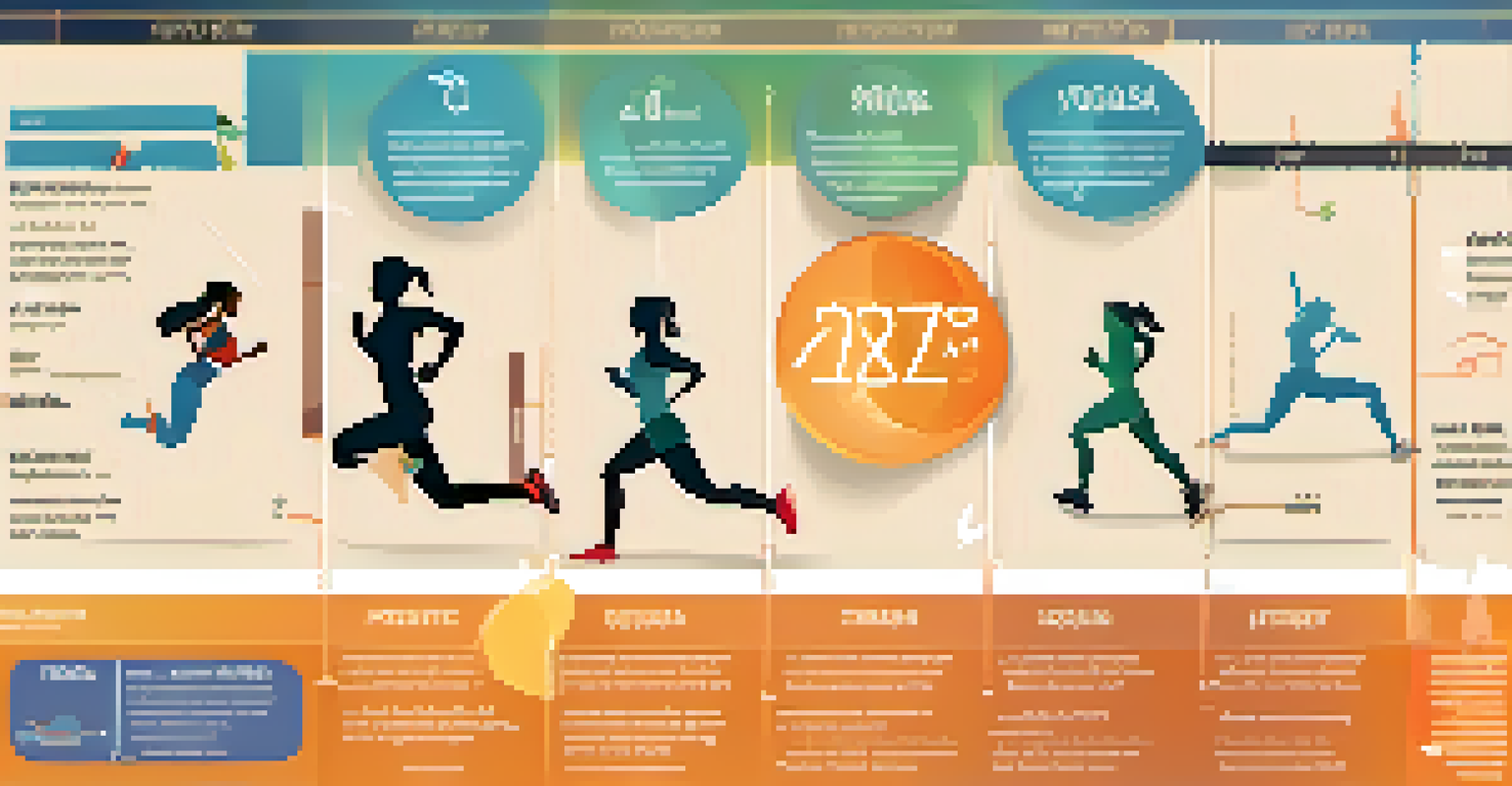Periodization Myths: Debunking Common Misconceptions in Training

Understanding Periodization: What It Really Means
Periodization is often misunderstood, leading to various myths. At its core, periodization is a structured approach to training that involves varying the intensity and volume over time. This strategy ensures that athletes can peak at the right moment while minimizing the risk of injury and burnout. By breaking training into distinct phases, it allows for targeted adaptations, making it an essential tool in any serious athlete's regimen.
The journey of a thousand miles begins with one step.
Many people think of periodization as a rigid plan that must be followed to the letter. However, it's actually quite flexible and can be adjusted based on an athlete's progress and needs. For instance, if an athlete is feeling fatigued, it’s perfectly acceptable to modify their program to allow for more recovery. This adaptability is crucial in making periodization work effectively, rather than being a strict set of rules.
In essence, understanding periodization means recognizing that it’s about balancing stress and recovery. This balance helps athletes optimize their performance over time, which is why it's crucial to grasp its true essence. With the right approach, periodization can be a game-changer for anyone looking to enhance their training outcomes.
Myth 1: Periodization is Only for Elite Athletes
One of the most common misconceptions is that periodization is exclusively for elite athletes. In reality, anyone can benefit from this training method, regardless of their fitness level. Whether you’re a weekend warrior or a seasoned pro, structured training can help you achieve your goals more effectively. Just like a blueprint helps build a house, periodization provides a framework for your training.

Even beginners can utilize periodization principles to ensure they’re not overtraining or undertraining. For example, a novice may have a simple cycle of increasing intensity followed by a recovery week, helping them adapt without overwhelming their body. This approach can lead to better results and a more enjoyable fitness journey.
Periodization Benefits Everyone
Periodization is a flexible training method that can enhance performance for athletes of all levels, from beginners to elite competitors.
So, whether you’re lifting weights, training for a marathon, or just trying to get healthier, remember that periodization isn’t just for the elite—it's for everyone aiming for progress.
Myth 2: Periodization Requires Complex Calculations
Another prevalent myth is that periodization demands advanced math skills or complicated calculations. The truth is, while some athletes might use detailed formulas, you can keep it simple and still reap the benefits. A straightforward approach can involve fluctuating your workout intensity and volume based on how you feel or your specific goals.
Success is the sum of small efforts, repeated day in and day out.
For instance, if you’re aiming to improve your strength, you might spend a few weeks focusing on heavier weights with lower reps before switching to lighter weights with higher reps for endurance. This doesn’t require calculators or spreadsheets—just a basic understanding of your training goals and a willingness to adapt.
Ultimately, periodization can be as simple or as complex as you want it to be. The key is to listen to your body and adjust your training according to your needs, rather than getting bogged down in numbers.
Myth 3: All Periodization Models Are the Same
Many people believe that there’s only one correct way to implement periodization. In reality, there are several models, each with its own strengths and weaknesses. From linear to undulating, the variety allows trainers and athletes to choose a method that best fits their individual goals and lifestyles.
For example, linear periodization involves gradually increasing intensity over time, while undulating periodization varies the intensity and volume more frequently. This flexibility means that athletes can tailor their training to their specific needs, whether they’re preparing for a competition or simply looking to improve their overall fitness.
Adapt Plans as Needed
It's crucial to understand that adapting your periodization plan mid-cycle is not only acceptable but can lead to better results and prevent burnout.
Understanding that different approaches exist empowers athletes to find what works best for them. By exploring various models, you can create a personalized training plan that aligns with your objectives, making the journey toward your fitness goals much more effective.
Myth 4: You Can’t Change Your Plan Mid-Cycle
A common belief is that once you start a periodization plan, you can’t change it until the cycle is complete. This myth can lead to unnecessary frustration, as life and fitness journeys are rarely linear. In fact, modifying your training plan mid-cycle is not only acceptable but encouraged when needed.
For instance, if an athlete starts feeling overly fatigued or isn’t recovering well, adjusting their plan to include more rest or lighter workouts can be a smart move. This flexibility helps prevent burnout and injuries, allowing for long-term success rather than short-term adherence to a plan.
Embracing the idea of adaptability within your periodization plan can lead to better results. Remember, it’s about listening to your body and making smart adjustments to optimize your training experience.
Myth 5: Periodization Means You Can’t Have Fun
Some individuals think that periodization turns training into a chore, removing the enjoyment from exercise. However, this couldn’t be further from the truth! In fact, incorporating periodization can make your workouts more dynamic and engaging by adding variety.
By planning different phases of training, you can explore various workout styles—like strength training, endurance, or even fun activities like dance classes. This variety not only keeps things fresh but also helps prevent plateaus, making your training more enjoyable and effective.
Variety Keeps Training Fun
Incorporating periodization can actually make workouts more enjoyable by introducing variety and preventing plateaus in your fitness journey.
So, if you fear that periodization might suck the fun out of your workouts, think again! With the right approach, it can enhance your enjoyment and keep you motivated on your fitness journey.
Myth 6: Periodization is Only About Performance Goals
Many believe that periodization is solely for athletes looking to enhance performance. While it’s true that performance improvements are a significant focus, periodization also supports other fitness goals like weight loss, muscle gain, or overall health. It’s a versatile approach that can cater to a variety of objectives.
For example, someone looking to lose weight may use periodization to alternate between high-intensity workouts and recovery periods, optimizing fat loss while ensuring they don’t become overwhelmed. This structured variation can help maintain motivation and avoid burnout during the weight loss journey.

Ultimately, periodization is about creating a balanced training plan that aligns with your personal goals. Whether you want to improve performance or simply feel better in your body, periodization can be a helpful framework to guide your training.
Conclusion: Embracing Accurate Understanding of Periodization
As we’ve explored, many myths surround periodization, often causing confusion and discouragement. By debunking these misconceptions, it becomes clear that periodization is an adaptable and beneficial approach for anyone looking to improve their training. Understanding its principles can empower you to take charge of your fitness journey.
It’s important to remember that periodization isn’t just a rigid framework set in stone; it’s a guide that can be tailored to suit your needs and goals. Whether you’re a beginner or a seasoned athlete, embracing periodization can lead to more effective training and lasting results.
So, as you move forward in your fitness journey, keep these insights in mind. By shedding light on the truths of periodization, you can navigate your training with confidence and clarity, ultimately leading to a healthier, happier you.